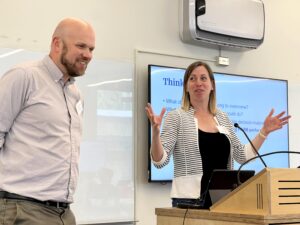Coming together for the betterment of Multi-Unit Residential Buildings, a gathering at U of T makes a pitch for ongoing research

What do you get when you bring together researchers, engineers, architects, property developers, contractors, consultants, municipalities and public health interests? The result, using the power of shared knowledge, is creating better housing. That’s the power of collaboration when applied to researching and developing multi-unit residential buildings, known as MURBs.
MURBs are the fastest-growing segment of housing in dense urban settings. With such a large segment of our population moving into these buildings which often contain hundreds of households, this means many families are exposed to the variety of performance issues MURB residents experience – including acoustic and thermal discomfort, lack of control, odour and contaminant transfer, just to name a few. Using current funding from the Natural Sciences and Engineering Research Council of Canada (NSERC), a collaborative effort has enabled research across a wide spectrum of topics related to MURB performance. While it might otherwise be unattainable for individual small companies to engage in costly research, when teamed together with university researchers and the accompanied funding, the shared results can be shared widely and benefit all.
Helping to fill this knowledge gap within the MURB realm, University of Toronto and Carleton University research teams have partnered with a NSERC Alliance. Led by U of T Prof. Marianne Touchie (co-appointed to CivMin and MIE) and Prof. Liam O’Brien, a professor of civil and environmental engineering at Carleton, the collaboration of the past three years meant the team had probed several areas of interest. The result became the joint event with multiple stakeholders, the Unlocking the Potential of MURBs held at the U of T on May 28.

“We have a five-year NSERC Alliance Society grant together, which is all about unlocking the potential of multi-unit residential building performance. Basically, what we’re trying to do is get some feedback on how far we’ve come. Areas like technical barriers and solutions to implementing some of our recommendations.” says Touchie. Then, with an eye to continuing the research together, “We’re doing a pitch for a new five-year program that involves a lot of these for-profit partners. It’s kind of a different model than what we did the first time around. We want to engage the end users more deeply into this next part of the research.” And, noting the deep ties U of T enjoys with industry, “We have a number of alumni too from various engineering companies.”
The two institutions enjoy complementary skills and backgrounds with the two leading faculty members and nine graduate students, are tackling the issues individual companies can’t afford to research on their own. The cooperative effort came by some fortuitous connections and similar interests, “We realized we were at similar career stages and we both had this passion for multi-unit residential areas,” recalls O’Brien.

Emphasizing the long-term efforts planned for this important area, “We’re halfway through a project all about multi-unit residential buildings, which is a topic that’s surprisingly not gotten enough research, even though it constitutes most of our new housing construction,” O’Brien says. “The problems are not just technical, but also process oriented. So it’s making sure that the right people are involved at the right times. It’s not just about new technologies; those are the challenges we’re facing.”
The gathering saw 13 speakers over a variety of topics, including indoor air quality (IAQ), indoor environmental quality (IEQ), acoustic comfort, airflow, insulation, life cycle assessment (LCA) and more. After each session those gathered engaged in breakout sessions, sparking discussions at each table.
Touchie and O’Brien hope to garner interest to renew their ongoing research in MURBs for another five years and beyond.
By Phill Snel